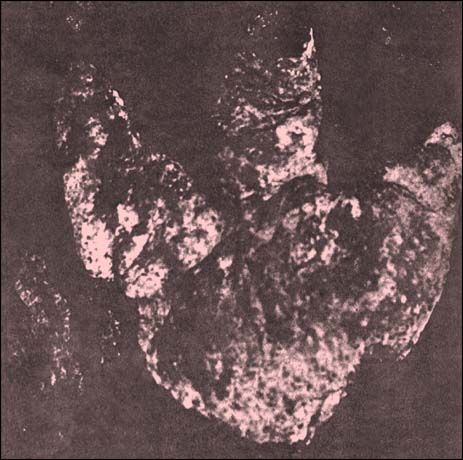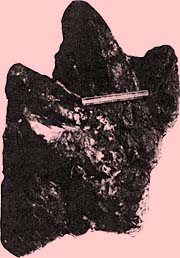
|
|
|
DINOSAUR TRACKS IN THE ROOFS OF COAL MINESA STRANGE PHENOMENON NOTED IN UTAH AND COLORADOBy WILLIAM PETERSONDIRECTOR AND GEOLOGIST, AGRICULTURAL EXPERIMENT STATION, UTAH AGRICULTURAL COLLEGE, LOGAN, UTAH |
|
To view the tracks of ancient Cretaceous monsters is not an entirely new experience, but to view these tracks from beneath instead of from above is somewhat of a novelty. This is a privilege open to those interested in the ancient life of the Cretaceous seas of Utah and Colorado. It was the writer's good fortune to spend three summers in a detailed survey and inspection of the coal deposits of Utah and Colorado. While he was examining the underground workings of many of the mines, attention was called to certain protuberances from the coal seam roof. A definite shape had been recognized in the case of some of these, though most of them were spoken of as "carbuncles," "lumps," and under similar terms. In areas where the coal was low these protuberances had to be removed to give room for the mine hauling, for some of them projected as much as a foot below the roof of the coal seam. In some places the projections appear in groups while in others they are solitary.
After inspecting hundreds of these protuberances, the writer agrees with some of the mine foremen and superintendents that these peculiar formations undoubtedly had their origin as tracks of ancient monsters which tramped through or around the border of the Cretaceous sea. The tracks seem to have been made at a time when the peat accumulation was covered with a foot or more of mud. The layer of mud was not sufficiently thick to support the weight of the animal walking over it. The feet sank through the mud several inches, or even more than a foot at times, into the soft, yielding peat underneath. Some mud was pushed into the peat as the animal brought down its weight, and as it drew out its foot, the footprint would be filled with mud from above. As time went on, nature's distillation reduced the peat to coal, and the mud with its track projections was converted into solid rock. In most places the coal is easily separated from the roof, leaving the track-shaped protuberance extending partially or wholly as a definite appendage from the ceiling. When the coal is completely removed, the tracks appear in various forms. In some cases the footprints project only part way through the roof and in others they project so far that a clear space is shown between the portion of the track represented by the toes and the solid roof. It is interesting to note that, as far as observed, the largest tracks are the ones which protrude farthest from the rock roof. The material filling the track varies slightly but is for the most part an arenaceous shale or argillaceous sandstone. The animals seem to have walked for the most part along trails or definite paths. It was noted that some of these paths are twenty or thirty feet in width, and the exposures in many entries and rooms of the coal mines show them to be comparatively straight in alignment. The individual tracks in the paths are seldom clearly outlined and only when one of the animals has traveled independently does every imprint become distinct. In several places it has happened that an entry of the coal mine has followed approximately the path of a single animal, thus exposing several of the tracks for measurement and comparison. Seven consecutive tracks are shown in the old Ballard Mine on the property of the American Fuel Company, located on the Denver and Rio Grande Railroad about 8 miles north of Thompson Springs. These tracks are among the largest observed and the measurements are shown in the diagram on the right.
In a different entry of the mine, tracks of similar size are found, and by courtesy of the company one of these was taken down and shipped to the Geology Museum of the Utah Agricultural College at Logan. On this page is shown a photograph of this track with a 12-inch rule placed on it for comparison. The track measures 3 inches between the spread of the outer toes and 32 inches from the heel to the front of the middle toe. Near the point of separation the toes are from 6 to 8 inches in diameter, and the toes are so pointed as to indicate the presence of rather sharp claws on the end of each toe. In the mine at Castle Gate, Utah, a photograph was taken of one of the tracks as it appeared in the roof of the mine before removal. The photograph (see first page) is furnished by courtesy of Mr. Watts of the Utah Fuel Company. This track, which is similar in character to those mentioned above, is somewhat smaller than they, being only 24 inches between the spread of the toes and extending for about the same distance if measured from the heel to the front of the middle toe. Only one track smaller than this has been measured, that in the mine at Standardville in Spring Caņon, the length of which is only 16 inches; however, it is similar in other respects to the Castle Gate track. Two casts of tracks have recently been obtained by workmen of the United States Fuel Company at the Panther Mine1. |
||
The tracks referred to in this article have been observed by the writer at intervals over an area more than one hundred miles in extent and in different seams of coal, which represent stratigraphic thickness of more than two hundred feet of sandstone including three or four beds of coal. The coal seams total in thickness approximately thirty-five feet. The deposit is near the base of the Mesa Verde formation of the Upper Cretaceous. The tracks are all of the three-toed type and seem to have been made by an animal that walked only on its hind feet. In one place, where the roof of the mine was badly caved, careful examination was made for any trace of either front feet or tail track, but no evidence of either was found. The most startling thing about the tracks is their enormous size. The writer has examined painstakingly the feet of the mounted skeletons of the Apatosaurus, Ceratosaurus, Claosaurus, Hadrosaurus, and others, but none apparently have feet large enough to fit these tracks. Dr. W. D. Matthew of the American Museum interprets the tracks as having been made by a member of the deinodont family of dinosaurs, of which the Tyrannosaurus is the largest known type. He further describes the Tyrannosaurus as "the climax of evolution of the giant flesh-eating dinosaurs. It reached a length of 47 feet and in bulk must have equalled the mammoth, mastodon, or the largest living elephants. The massive hind limbs, supporting the whole weight of the body, exceeded the limbs of the great proboscideans in bulk, and in a standing position the animal was from 18 to 20 feet high as against 11 feet or so for the largest African elephant or the southern mammoth. The head was 4 feet, 3 inches long; 3 feet, 4 inches deep; and 2 feet, 9 inches wide. The long deep powerful jaws are armed with teeth from 3 to 6 inches long." The front limbs were small and were probab-ly used only in capturing and gathering food. The great bulk of the body would imply slow movement, and that food was obtained from the shallow water of the Late Cretaceous sea. | ||

The skeleton of the Tryannosaurus in the American Museum. ______________________________ 1There are unauthenticated reports that similar tracks have been observed on the roof of the coal mine at Somerset, Colorado. |
||
Return to: |

